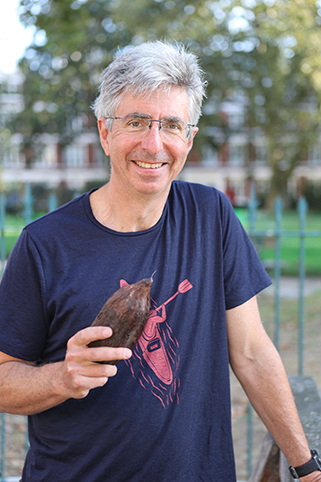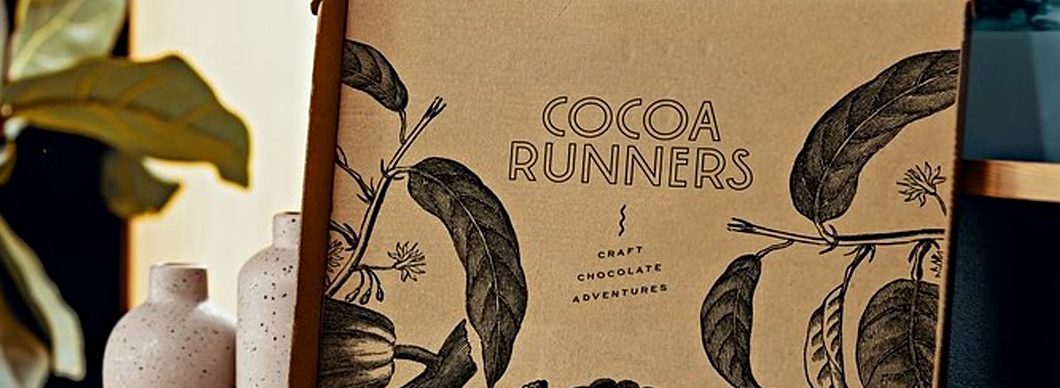
Spotlight on Spencer Hyman
Approx read time: 5 minutes
Over a decade ago, leading chocolate aficionado Spencer Hyman co-founded Cocoa Runners with Simon Palethorpe. Although his career began in the very different industry of toys and video games (starting with making cabbage patch dolls in Thailand to becoming the launch GM for Amazon UK, France and Germany for their software, video games, electronics and toys), Spencer has retained a passion for craft chocolate from the very beginning. Combining his desire to share the finest craft chocolate with people and his business acumen, Spencer decided to begin a new adventure in 2012 as a craft chocolate stockist. Over the years, his knowledge of all things chocolate has expanded greatly, regularly making TV appearances and speaking at conferences. Spencer also runs chocolate tastings from Cocoa Runners’ head office, both virtually and in-person, where he will explain how to savour the flavours of a bar to the origins and chocolate makers’ stories.
The past few years have seen us collaborate with Cocoa Runners many times, exploring the parallels between wine and chocolate (not to mention simply enjoying a delicious combination!) through tastings, talks and fairs. With Easter fast approaching, we felt this was the perfect opportunity to learn a little more about Spencer and the world of craft chocolate. So, in a recent catch-up, we came armed with a few questions…

Could you give us a brief overview of how chocolate is made?
Chocolate starts with cocoa beans, which grow in pods on trees in the rainforest (or, sadly, what was the rainforest); once these are harvested, they are then fermented and dried (so, sort of like grapes up to this point). Following this, there are two options; the first is to turn the beans into mass-market processed ‘liquor’ or ‘couverture’ that is then remoulded by chocolate makers. The processes here involve ‘ultra-processing’ steps such as roasting and deshelling at high pressures along with alkalinization. The second option is to craft the chocolate much like making a fine wine – processes include meticulous sorting of the beans, small batch roasting, winnowing, conching, tempering and moulding.
Could you explain why you set up Cocoa Runners, and what the company’s values are?
We wanted to find the world’s best craft chocolate and share that with people. It tastes better for a start but is also healthier for you – it’s not ultra-processed, and you tend to eat less of it! It’s also better for the farmers who are growing the beans and, of course, the environment – We feel it’s important to be transparent about the industry and for people to understand where their chocolate has come from. Finally, We wanted to educate people on taste by teaching them how to savour and experience craft chocolate’s unique flavours.

Why do you feel that knowing the chocolate makers and where their beans are sourced from is so important?
There are two main reasons for this; the first is that knowing the provenance of your chocolate ensures you are getting the most flavoursome bars of the highest quality. The second reason is more conscientious in that it’s a way of ensuring the farmers who grow the beans are rewarded fairly with things like long-term contracts and are recognised for helping preserve the rainforest wherever possible.

When growing grapevines, factors such as the climate, soil type, altitude and aspect of the growing area make a significant difference to the resulting grapes. Is this the same for cocoa beans?
There are a surprising number of similarities between the processes of winemaking and chocolate making in fact. There are the more obvious examples, such as harvesting, but there are many other comparative factors, like the type of bean you use to make the chocolate, sort of like grape varieties, that impact the flavours and characteristics of the finished chocolate. Some wines are made from dried grapes – similarly, drying the cocoa beans is an important process of chocolate making and depending on how you do it (whether it is on racks, solar or fire-based drying), the resulting chocolate will differ. Fermentation is another huge factor, from how long to what type of yeast strains are used – these are things regularly tinkered with in winemaking, too, depending on the desired characteristics.
Approximately how many different varieties of beans are available to use in the production of chocolate? Are these ever mixed, or is it better to retain specific varietal characteristics?
Okay, so this gets super complex! The “old” view was that there were three sorts of cocoa beans: trinitario, criollo and forastero. However, we have since learnt that this is too simplistic. There are LOTS of other views and claims about cocoa varietals, and you’ll see all sorts of “guff” written on this topic, but for now, there is no overarching view. Of course, some clone varietals have been developed and engineered carefully so they are fast growing and disease resistant etc, but they generally taste awful.
Arguably, the reason we haven’t drawn a unanimous conclusion on this is because the whole area is far, far more complex to identify than wine or, if you want other examples, things like apples. This is because, with chocolate, we are consuming the seeds and not the fruit. So, whereas with grapevines, you can take a cutting of the vine and predict the grape variety that will produce, within a pod, the seeds can vary depending on how the plant or pod was initially germinated.
There are a significant number of flavour compounds in chocolate; does someone need palate training to detect these?
All flavour tasting needs training, the same as recognizing colours, although it is much harder because of things like the Laing Limit. I regularly host chocolate tasting experiences at Cocoa Runners, aiming to help people identify their palates and walk them through how to savour the all-important flavours.
In your eyes, what makes great craft chocolate?
It’s a similar principle to evaluating a wine: Does it have balance, length, intensity, and complexity?
Chocolate and Wine pairings
If you would like to indulge in some chocolate and wine pairings, we can hand-on-heart recommend the following matches (we can recommend them because we have tried and tested them all… many times!):
Orange Wine with 48% Milk Chocolate:
Naranjo Torontel Loncomilla Maturana with Hogarth Buttered Toast and Sea Salt
Tannat-based blend with 70% Dark Chocolate:
Le Faite Rouge AOC Saint Mont, Producteurs Plaimont with Duffy’s Rio Dulce, Guatemarle 70% Dark
Montepulciano with 80% Dark Chocolate:
Lonely Vineyard Montepulciano with Tosier Hacienda Limon, Ecuador 80% Dark
To find out more about Cocoa Runners, see their website: www.cocoarunners.com


